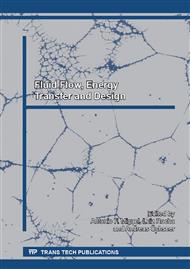p.51
p.58
p.64
p.71
p.88
p.97
p.107
p.113
p.123
Dynamical Study of a Molten Boundary Layer Ejected by Laminar Gas Flow
Abstract:
We consider in the present work the fusion laser cutting of stainless steel sheets under a nitrogen laminar gas jet. The molten metal is treated as a laminar and steady viscous incompressible fluid. The mathematical model describing our problem is set in terms of Navier-Stokes equations, solved numerically using the finite differences method, where the effect of the gas jet velocity on the molten boundary layer is considered. The generated shear stress occurring on the gas-liquid interface and its contribution in the momentum is carried out, and it is found that when the skin friction and the shear stress decrease, the thickness and the velocity at the edge of the molten boundary layer increase along the kerf surface. The layer thickness reduces when the assisting gas velocity is increased.
Info:
Periodical:
Pages:
88-93
Citation:
Online since:
January 2014
Authors:
Price:
Сopyright:
© 2014 Trans Tech Publications Ltd. All Rights Reserved
Share:
Citation:


